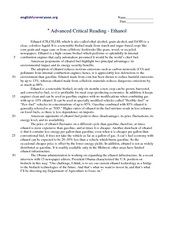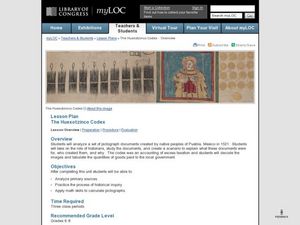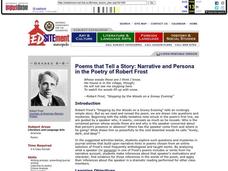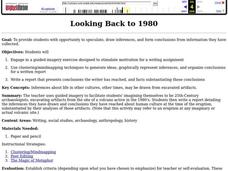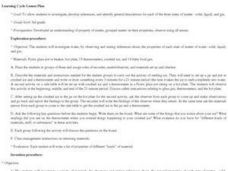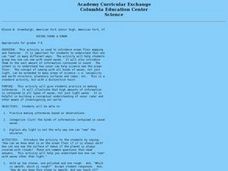Curated OER
Runaway Ad - Using Primary Documents
Students examine a runaway slave advertisement. For this American history lesson, students investigate a missing slave advertisement run by Thomas Jefferson in 1769. Students make inferences based on the advertisement.
Curated OER
A Wolf by the Ear
Students examine Thomas Jefferson's view of slavery. In this slavery lesson, students watch segments of the video "Slavery and the Making of America." Students respond to discussion questions as they watch the video and make inferences...
Curated OER
Rockin’ the World: Rock and Roll and Social Protest in 20th Century America
Students explore protest songs. In this interdisciplinary lesson, students examine issues-based music by summarizing lyrics and revealing inferences, generalizations, conclusions, and points of view found in the songs.
Curated OER
Advanced Critical Reading: Ethanol
In this advanced critical reading instructional activity, students read a passage about ethanol then answer questions. Students make inferences, determine author's purpose and use context clues to find the meaning of unknown words in the...
Curated OER
Literature-based Skill Building:Holesby Louis Sachar
In this literary elements worksheet, students read chapters 26, 27, and 28 of Holes by Louis Sachar and then respond to 13 short answer questions regarding setting, conflict, and inference.
Curated OER
European Agriculture
Learners make inferences on how physical geography affected the development of early civilizations and come up with solutions to global issues. In this physical geography lesson plan, students compare maps of the past to maps of today to...
Curated OER
Lesson PlanThe Huexotzinco Codex
Students examine primary sources that include pictographs from Puebla, Mexico. In this Huexotzinco Codex lesson, students perform historical analysis as they investigate the codex as they make inferences and draw conclusions about taxes...
Curated OER
Architecture of the Skeleton
Young scholars experiment with skeletons. For this bone health lesson, students analyze, construct, and perform comparative investigations with bones. They make inferences about the structure and function of various bones. This lesson...
Curated OER
The Huexotzinco Codex
Learners examine primary sources and perform historical analysis. In this Huexotzinco Codex lesson, students investigate the codex as they make inferences and draw conclusions
Curated OER
Cherstey: What was Cherstey like in the middle ages?
Students examine maps of a medieval village. In this medieval town lesson, students identify major buildings and make inferences about village life. Students could draw a modern day map of medieval Cherstey.
Curated OER
Weather Olympics
Students consider the effects of topography on climate patterns. In this earth science lesson, students research weather patterns and make inferences of how the land forms may create different climates. Students compare Celsius...
Curated OER
Exploring Religious Violence and Persecution in 16th Century Europe
Pupils watch a movie on religious violence in 16th century Europe and then write a background about a picture they are given on violence. In this religious violence lesson plan, students create the background by making inferences about...
Curated OER
Look Around You
Pupils make predictions about a book they are reading and use their background knowledge to make inferences. In this predictions lesson plan, students complete a worksheet that they are given.
Curated OER
Rudyard Kipling's "Rikki-Tikki-Tavi": Mixing Fact and Fiction
"Rikki-Tikki-Tavi," from The Jungle Book, offers young readers a chance to examine how Rudyard Kipling uses setting and personification to bring to life the brave mongoose who battles cobras to protect his family. Class members...
Curated OER
Where the Red Fern Grows Chapter 16-17
Find out how much your class understood of the listed chapters of Wilson Rawls' novel. Class members respond to eight plot and character questions before looking closely at an instance of personification from the text. The resource is...
Curated OER
Poems that Tell a Story: Narrative and Persona in the Poetry of Robert Frost
Students read and discuss poems by Robert Frost. Students collaborate in small groups to draw inferences about speakers' character and motives and to gather evidence supporting those inferences.
Curated OER
What Can We Learn From the Past?
Learners observe items from their past, making inferences and observations about their own culture based on these artifacts. Students then share with the class what they learned about their own culture, giving all learners more...
Curated OER
Looking Back to 1980
Students use clustering/mind mapping techniques to generate ideas, graphically represent inferences, organize their conclusions and write a report that presents conclusions the writer has reached, and facts substantiating those conclusions.
Curated OER
Carbons to Computers - 1
Students gather and classify information from observation of photographs; to have students differentiate between fact and inference.
Curated OER
It's All In The Rocks
Learners think critically to determine fact or inference when examining sedimentary layers with embedded fossils. Geology and evolutionary biology are introduced. They individually write a story about various diagrams and share their...
Curated OER
Scientific Inquiry
Students make inferences about what activities occur at different places in school. They form a hypothesis as to how space is used. They simulate how archeaologists explore past people by designing and conducting a research project.
Curated OER
Learning Cycle Lesson Plan
students investigate, develop inferences, and identify general descriptions for each of the three states of matter - solid, liquid, and gas. students investigate water, by observing and stating inferences about, the properties of each...
Curated OER
Seeing Sound and Sonar
Middle schoolers grasp how underwater animals can "see" using sound waves. They practice making inferences, and build a conceptual understanding of sonar radar.
Curated OER
Local Heart Rates
Students determine the type of data needed to test their inferences. As homework, they check and record heart rates of fellow students, teachers and family members. During their next class period, students enter all data into the database.
Other popular searches
- Making Inferences Worksheet
- Observation and Inferences
- Making Inferences in Reading
- Reading Making Inferences
- Making Inferences Grade 2
- Making Inferences Stories
- Lesson Making Inferences
- Inferences and Context Clues
- Generalizations / Inferences
- Inferences in Reading
- Reading Inferences
- Making Inferences 3rd Grade





